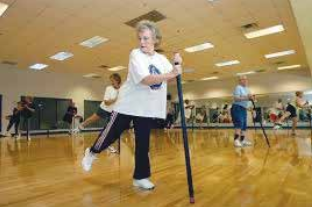
What is Osteoarthritis? Osteoarthritis (OA) is a painful degenerative joint condition that progressively worsens over time. It affects the entire joint, and most commonly occurs in our weight-bearing joints, such as hips, knees, and spine. Osteoarthritis is the most common reason for not being physically active as people age. About 15 per cent of Canadians over the age of 20 have osteoarthritis, or about one in seven adults.
WHAT ARE THE SYMPTOMS OF OSTEOARTHRITIS?
The symptoms of OA develop slowly over years but can have a sudden or insidious onset. These symptoms include:
• Pain on weight bearing and joint noises

• Stiffness and reduced range of motion
• Feeling of instability (lack of trust)
• Pain at rest and joint swelling
RISK FACTORS FOR OSTEOARTHRITIS
Risk factors fit into two categories: modifiable — things we change, and non-modifiable — things we cannot change. Modifiable Risk factors include:
• Joint injury
• Joint overload
• Excess weight
• Physical inactivity
• Muscle weakness
Non-modifiable risk factors:
• Age — over 65 years of age
• Sex — Female more than males
• Genetics
HOW IS OSTEOARTHRITIS DIAGNOSED?
It is recommended that the diagnosis of OA be made by taking into account risk factors, presence of pain/symptoms, and findings on clinical examination. Imaging (x-rays) is still often used to diagnose OA, but most clinical guidelines now tell us that imaging is no longer required to diagnose OA. Imaging is only a piece of the puzzle; it does not always give us the whole picture. Only about half of people who experience OA pain have no visible findings on their imaging, and It is common to see changes on imaging that suggests OA, while the person has no symptoms. Imaging is potentially more helpful in the later stages, when surgery is being suggested.
HOW IS OSTEOARTHRITIS TREATED?

The first line of treatment for OA is education, exercise and weight reduction. Different types of exercises can have positive effects on symptoms from OA — such as strength, aerobic or neuromuscular training. This first line of treatment is often not adequately tried before people pursue other types of treatment. The second line of treatment includes pharmacological pain relief, aids, and passive treatments given by a therapist. These options can often be helpful in the short term, but do not help things in the long term- and should not replace the first line of treatment. The last treatment option for OA is surgery- and should only be considered if someone is not responding to the first two lines of treatment.
HOW CAN PHYSIOTHERAPY HELP?
Physiotherapists are well suited to treat osteoarthritis. As noted above, OA presents with muscle weakness, reduced range of motion, and pain. Physiotherapists specialize in providing education on such things as activity modification, pain science, and self-management strategies. A physiotherapist can help to correct movement, provide manual therapy techniques to help with ROM and pain and prescribe exercise to help build strong muscles. They can provide you with exercises that are best suited for your current ability, and safely help you progress, and help you manage any bumps in the road along the way.
If you have any questions about osteoarthritis or are not sure where the best place to start is, give physiotherapist Megan Lautner at Donald Physiotherapy in Davidson a call at 306-933-3372.
-Megan Lautner

Leave a Reply